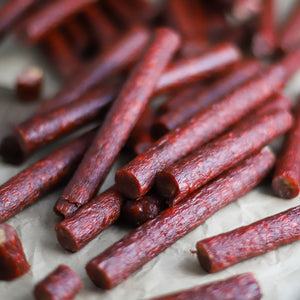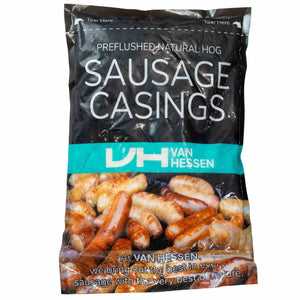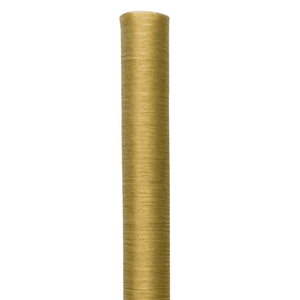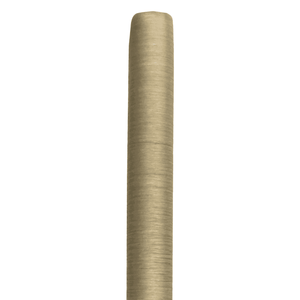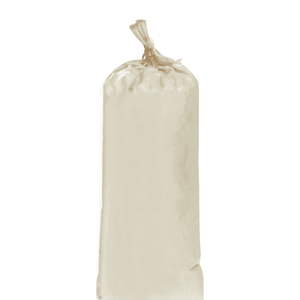19 products
An Introduction to Casings
Learn about Natural, Collagen & Fibrous Casings from Master Meat Crafter Mark Hannui
Frequently Asked Questions About Sausage Casings
What are the different types of sausage casings?
There are three major kinds of sausage casings: natural, collagen and fibrous casings. Each have a different texture with natural sausage casings being the snappiest to fibrous casings being the hardest. To make delicious hot dogs and bratwurst, summer sausage and snack sticks (and much more), read on below.
What are sausage casings made of?
Natural sausage casings are generally made of the sub mucose part of an animal's intestines.
On another hand, collagen casings are made, like their name suggests, from animal collagen, usually extracted from animal hide.
Finally, fibrous casings are made using plant cellulose, making them the strongest type of sausage casing with a paper-like texture.
What are natural sausage casings?
Natural sausage casings come from beef, pigs and sheep intestines (inner mucosa). The use of this type of casing goes back centuries — it’s one of the oldest forms of sausage-making, a classic in the sausage tradition. As you might imagine though, they are not vegetarian sausage casings. Natural sausage casings have a few major characteristics:
- They can be used for fresh sausage, smoked sausage, snack sticks, hot dogs, all kinds of things
- They have a great snap
- They do require more prep than some other casings
What is natural sausage casing made of?
There are three major types of natural sausage casings:
Beef rounds
These are used for ring bologna, liver sausage and landjäger. They are very heavily salted, so you need to rinse them in cold water then run warm water through them. The best treatment is to soak them overnight in cold water and soak them in warm water for about 30 minutes before beginning your sausage stuffing work.
Hog sausage casings
Hog casings are specifically used for making fresh bratwurst. They are also used for making smoked polish sausages, ring bologna with a small diameter and landjäger. Hog casing are therefore also one of the most popular types of breafast sausage casings.
Sheep sausage casing
Sheep casings are the most tender of the natural casings; they’re used for hot dogs, snack sticks and breakfast links. This type of natural sausage casing is commonly used as breakfast sausage casing as well as it is flavorful yet soft.
How are natural sausage casings packed and delivered to your door?
Natural sausage casings are packed in a saline solution or salt-packed. The saline solution is designed for quick use, so once you rinse the sausage casings off, you can use them within about 30 minutes after soaking in warm water. If salt-packed (in other words, heavily salted), you need to rinse off the salt, soak them in cold water and run cold water through them. After about half an hour of soaking in warm water, they can be used for stuffing.
How are natural sausage casings sold?
Sausage casings come in hanks. What’s a hank? It’s about 90 meters long. Beef rounds are designed for ring baloney and will stuff roughly about 60 pounds of meat. For hog casings, there are many different sizes based on the diameter you’re looking for. They stuff an average of 90 to 175 pounds of meat in each hog casing. Sheep casings also depend upon size; the smaller the sheep casing the less you will get, but they will stuff about 40 to 60 pounds per hank. PS Seasoning also offers smaller “home packs” for sheep and hog casing (“home pack”) designed for home users just getting started — you can make close to 25 pounds of meat with them.
Can you eat natural sausage casings?
Yes! Natural sausage casings are edible so you don't have to worry about peeling it off the sausage.
How long do natural casings last?
PS Seasoning’s natural sausage casings can last two years or longer unopened. After you open them, drain the water. You don’t need to put them in the freezer, as it could break down the texture of the casing over time and it won’t perform as well as it would in its original form. In the refrigerator, they should last four to six months.
What are collagen casings?
Salted collagen casings are made from beef collagen or pork hides. They are less expensive than natural casings and are easier to use, since they are very uniform and do not require much pre-soaking; you can use them just as they come off the strand, ready to go. This matters because it means you can process collagen casings faster, and you don’t have to worry about having knots in your casings like you might with natural casings.
What are the different types of collagen casings?
PS Seasoning has three main types of collagen casings:
Fresh, which is a casing that can be used for making fresh bratwurst or breakfast links as breakfast sausage casing, depending upon what size casing you want to go with.
Processed collagen casing is a bit stronger and thicker than fresh collagen to hold up to the processing schedule in the smokehouse, and can be used for making polish sausage, pre-cooked brats, or even hot dogs or wieners depending on what size you want to go with. They are also very popular as salami casing.
Snack stick collagen casing, which is generally in a clear or mahogany color, and gives you a definitive color and consistent sizing. You can twist them or hang them long in the smokehouse.
As a bonus, we also offer a collagen ring bologna casing. This offers consistent sizing out of the gate (unlike a natural casing) and has a string tied to each end. It’s very easy to use, but we do recommend peeling off the casing once you’re ready to eat the meat (although it is edible).
Can you eat collagen sausage casings?
Collagen casings are edible, but generally people peel them off.
How do you prepare a collagen casing for stuffing?
Collagen casings are ready to go right out of the box or bag! They’re designed to go on the horn so that the casing pulls off from the top and not the inside of the product.
Can you overstuff a collagen casing?
Yes, you can definitely overstuff a collagen casing. You want to stuff them so wrinkles are coming out of the product when you’re stuffing it but so you can squeeze your fingers and still kind of squeeze it together. However, if you stuff too tight and you hang them in a smokehouse, they will break from the weight. The casing has to be able to move around the smoke rod also, so if you try to twist an overstuffed casing, it will split.
How much does a collagen sausage casing strand stuff?
Each collagen sausage casing strand can stuff anywhere from 9 to 12 pounds of meat; sometimes more, sometimes less, depending on the diameter of your product.
Can you twist-link collagen casing?
Yes, you can! It’s a little bit more difficult than with a natural casing, but certainly doable. Try to tie a string between your twists to keep the knot solid as you go.
Can collagen casings be hung in a smoker?
Yes, they can, but you want to make sure that you’re using a processed casing — they are stronger and hold up better to the weight hanging. You can stuff them and hang them in long, two to three foot lengths, or twist them into measurements of six inches to a foot, whatever your preference is.
How long do collagen casings last?
Collagen casings can easily last a year or two unopened, if not longer. After you open them, make sure to keep them in an airtight bag and store in the refrigerator — freezing temperatures and extreme heat should be avoided.
What are fibrous casings?
Fibrous casings are a man-made product that comes from the collagen of beef and pork; they are also made from a specific tree called the Abaca. The fibers in the Abaca tree are very strong yet easy to work with — they’re very stretchable.
Fibrous sausage casings come in different varieties, from clear to mahogany; they also have certain coatings on the inside to help you achieve the texture and taste you’re looking for.
Fibrous casings are the standard in the industry for summer sausage casings, salami and pepperoni, as they are very simple to use and very consistent. It is so common that they are even referred to as "salami casing".
Are fibrous sausage casings edible?
While fibrous casings are edible, we do not recommend eating them as they are designed to be peeled off summer sausage, pepperoni, etc. So while the answer to “can you eat summer sausage casing” is a yes, we think you might enjoy it better without it.
What are the types of fibrous casings?
There’s two main kinds of fibrous casings — clear and mahogany. You can also get them printed with a design. The benefit of a mahogany casing is you’ll get a consistent color when you are smoking the sausage. However, a lot of customers like using clear casing to put their mark on the product for its finished look.
What’s a pre-stuck casing?
Pre-stuck casing has little holes all through it to allow air to escape during the stuffing process. This helps prevent air pockets inside the sausage, or fat gel pockets that you sometimes see.
Can you overstuff a fibrous casing?
You can stuff a fibrous casing pretty full, but if you overstuff them, they will split open. Stuff the fibrous casing until it is tight, and then you will be good to go.
How do you prepare fibrous sausage casings for stuffing?
Fibrous casings are very easy to prepare! Just before stuffing, you want to soak them in warm water for about 30 minutes. When you’re ready to stuff, squeeze the water out and place the casing on the horn. Fill and tie and on you go.
Do you need a special stuffer horn for fibrous sausage casings?
You don’t need a special stuffing horn for fibrous sausage casings. You just want to make sure you have one that’s the largest size you can fit for the casing, because it makes it easier to fill.
Soaking the casing helps the fibrous casing stretch, and makes it more pliable, but make sure you squeeze the water out before you put it on the horn. When you are filling the casing from the horn, you want to fill it somewhat tight, so your hand is keeping the air out of the casing while you stuff.
Will the fibrous sausage casings stick?
Some fibrous casings will stick to the meat — it depends on the inside coating of the casing. Regular fibrous casing has a partial meat-cling coating and appealing character. If you find your casing is peeling hard, it may be the casing has a meat-cling property and was designed for products like salami, which kind of hangs at room temperature, and in which the casing shrinks with the product.
How should fibrous sausage casings be stored?
Fibrous casings are stored at room temperature until ready to use. After you soak them in water, you want to squeeze the water out and hang them to dry at room temperature. After they dry, store them in an airtight bag or container.
For more information on sausage casings, check out our individual products above or our Sausage Casings 101 blog, with video and even more details.


